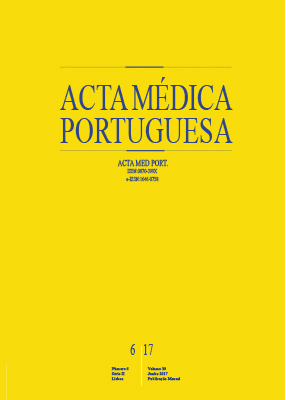Diabetes Screening in Patients with Macrovascular Coronary Disease: Are the New European Guidelines a Step Backwards?
DOI:
https://doi.org/10.20344/amp.7990Keywords:
Coronary Artery Disease, Diabetes Mellitus, Type 2, Glucose Tolerance Test, Hemoglobin A, Glycosylated, Mass ScreeningAbstract
Background: The new European guidelines on diabetes mellitus and cardiovascular diseases propose that the FINnish Diabetes RIsk SCore should be used to evaluate the risk of diabetes mellitus and that diabetes mellitus screening in coronary artery disease patients should be based on fasting glucose and HbA1c. The 2 hour oral glucose tolerance test, recommended for all pts in the previous guidelines, is now only recommended for ‘inconclusive’ cases. We aimed to evaluate this new strategy.
Material and Methods: Fasting glucose, HbA1c and glucose tolerance test (75 g, 2h) were prospectively evaluated in a consecutive group of pts with coronary artery disease. ADA criteria (both glucose tolerance test and HbA1c) were used to define diabetes mellitus and pre-diabetes mellitus. Diabetes mellitus risk was evaluated according to the FINnish Diabetes RIsk SCore.
Results: A total of 135 patients were included (mean age 62.3 +/- 13.1 years, 99 males). Glucose tolerance test and HbA1c together diagnosed 18 (13.3%) new cases of diabetes mellitus and 77 (57.0%) patients with pre-diabetes mellitus. Fasting glucose + HbA1c (guidelines strategy) identified 12/18 patients with diabetes mellitus (Sens 66.7%; negative predictive value 95.1%; Kappa 0.78; p < 0.0001) and 83/95 patients with glucose anomalies (pre- diabetes mellitus + diabetes mellitus) (Sens 87.4%; negative predictive value 76.9%). Performing glucose tolerance test in the 29 patients with an elevated FINnish Diabetes RIsk SCore would allow identifying 15/18 patients with diabetes mellitus (Sens 83.3%; negative predictive value 97.5%; Kappa 0.85; p < 0.0001) and 86/95 patients with glucose anomalies (Sens 90.5%; negative predictive value 81.6%).
Discussion: Although this strategy improved the screening accuracy, one in each six patients with diabetes mellitus would still remain undiagnosed, as compared to measuring HbA1c and performing an glucose tolerance test in all patients.
Conclusion: Using the FINnish Diabetes RIsk SCore to select candidates to additional glucose tolerance test improves the accuracy for identifying diabetic patients, as compared with fasting glucose + HbA1c alone. However, 1/6 patients diabetes mellitus is still left undiagnosed with this strategy proposed by the current guidelines.
Downloads
Downloads
Published
How to Cite
Issue
Section
License
All the articles published in the AMP are open access and comply with the requirements of funding agencies or academic institutions. The AMP is governed by the terms of the Creative Commons ‘Attribution – Non-Commercial Use - (CC-BY-NC)’ license, regarding the use by third parties.
It is the author’s responsibility to obtain approval for the reproduction of figures, tables, etc. from other publications.
Upon acceptance of an article for publication, the authors will be asked to complete the ICMJE “Copyright Liability and Copyright Sharing Statement “(http://www.actamedicaportuguesa.com/info/AMP-NormasPublicacao.pdf) and the “Declaration of Potential Conflicts of Interest” (http:// www.icmje.org/conflicts-of-interest). An e-mail will be sent to the corresponding author to acknowledge receipt of the manuscript.
After publication, the authors are authorised to make their articles available in repositories of their institutions of origin, as long as they always mention where they were published and according to the Creative Commons license.









